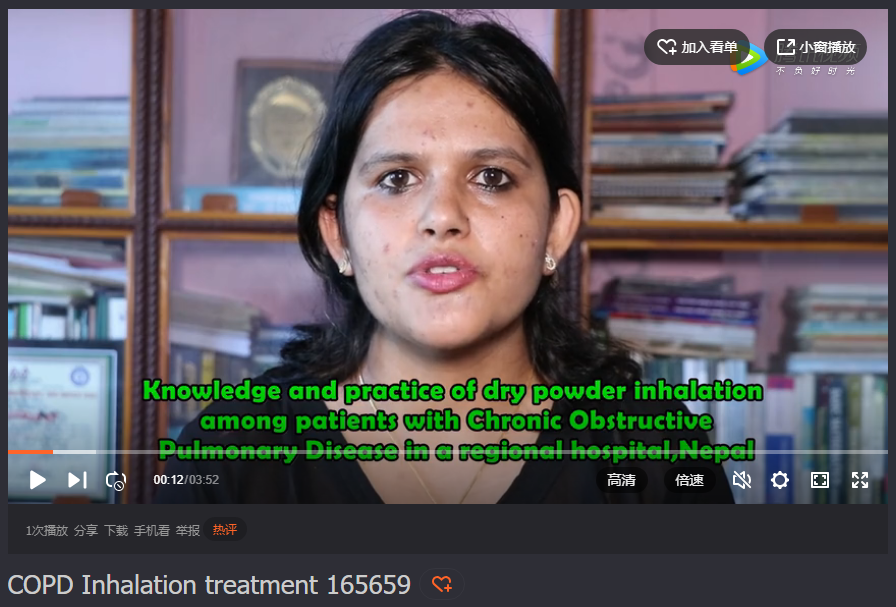9 0 6 7 6
论文已发表
注册即可获取德孚的最新动态
IF 收录期刊
- 2.6 Breast Cancer (Dove Med Press)
- 3.9 Clin Epidemiol
- 3.3 Cancer Manag Res
- 3.9 Infect Drug Resist
- 3.6 Clin Interv Aging
- 4.8 Drug Des Dev Ther
- 2.8 Int J Chronic Obstr
- 8.0 Int J Nanomed
- 2.3 Int J Women's Health
- 3.2 Neuropsych Dis Treat
- 4.0 OncoTargets Ther
- 2.2 Patient Prefer Adher
- 2.8 Ther Clin Risk Manag
- 2.7 J Pain Res
- 3.3 Diabet Metab Synd Ob
- 4.3 Psychol Res Behav Ma
- 3.4 Nat Sci Sleep
- 1.9 Pharmgenomics Pers Med
- 3.5 Risk Manag Healthc Policy
- 4.5 J Inflamm Res
- 2.3 Int J Gen Med
- 4.1 J Hepatocell Carcinoma
- 3.2 J Asthma Allergy
- 2.3 Clin Cosmet Investig Dermatol
- 3.3 J Multidiscip Healthc

Knowledge and practice of dry powder inhalation among patients with chronic obstructive pulmonary disease in a regional hospital, Nepal
Authors Baral MA
Received 3 April 2018
Accepted for publication 14 June 2018
Published 24 December 2018 Volume 2019:12 Pages 31—37
DOI https://doi.org/10.2147/IJGM.S165659
Checked for plagiarism Yes
Review by Single-blind
Peer reviewers approved by Dr Colin Mak
Peer reviewer comments 2
Editor who approved publication: Dr Scott Fraser
Purpose: Dry powder inhalation is a cornerstone of
treatment in patients with COPD. This study was undertaken to study the
knowledge and practice of dry powder inhalation among such patients.
Patients and methods: The current study was a cross-sectional study conducted in Western
Regional Hospital, Pokhara, Nepal. The study was conducted among 204 COPD
patients (outpatients and inpatients) aged ≥20 years who had been using
rotahaler, a dry powder inhaler device, and a purposive sampling technique was
used. Data were collected from February 28, 2016, to March 26, 2016. A
questionnaire was administered by the interviewer to assess the knowledge about
dry powder inhaler (DPI) and inhalation while a Dutch Asthma Foundation
observation checklist for rotahaler was used to evaluate the practice of dry
powder inhalation. The collected data were analyzed using descriptive
statistics and inferential statistics (chi-square test).
Results: Findings
from the study showed that a low proportion of the respondents had accurate
knowledge and correctly practiced inhalation technique (3.9%). However,
majority of the respondents (77.5%) performed the critical steps correctly. The
correct practice of dry powder inhalation was associated with younger age (p =0.008), urban
residence (p =0.024),
and literacy (p =0.012).
The practice was comparatively more accurate among those who received practical
classes/demonstration on the inhalation technique from health care providers (p <0.001).
Conclusion: Based
on the study findings, it was concluded that COPD patients attending Western
Regional Hospital possessed satisfactory knowledge but poor technique of dry
powder inhalation. The most important modifiable factor for incorrect practice
was a lack of demonstration on inhalation technique by the health care
provider. Therefore, it is necessary for health care providers to supplement
verbal instruction on dry powder inhalation with demonstration and
re-demonstration from the patients to improve the knowledge and practice of dry
powder inhalation for COPD patients.
Keywords: knowledge,
practice, chronic obstructive pulmonary disease, dry powder inhalation,
rotahaler
摘要视频链接:Dry powder
inhalation for COPD
